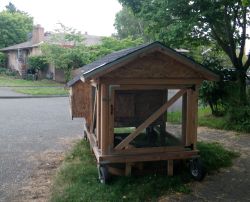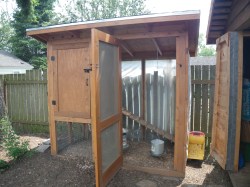
Jennifer Keeler feeding her chicken.
Here are a few things you should know about keeping backyard chickens: Poultry are “poop machines” — but cleaning up after them is “less maintenance than a cat’s litter box.” You can let them range free around the yard — just watch out for predatory eagles (and your garden: “Chickens will annihilate it.”). Chickens are “not pets,” except when “they’re very much our pets.” Clearly, fowl guardianship is a highly personal endeavor.
I gleaned these scraps of wisdom last Saturday, when I attended a citywide open house of sorts for backyard chicken enthusiasts. On Seattle Tilth’s annual Chicken Coop & Urban Farm Tour, the keepers of the local flocks open up their coops and let the curious poke around. Of course, I was among them. I’ve been taken with the fantasy of backyard chickens for awhile now — waking in the morning to soft bawk-bawk-bawking, whipping up fluffy omelets with just-laid eggs — so I had to see how closely real chicken husbandry matched my daydreams. Is it difficult? Is it stinky? Do I really have what it takes to be a hen mother? It was time to find out.
Unlike in my Midwestern hometown, where my friend must force her 4-year-old son into 4-H so she can get an otherwise-verboten chicken permit, Seattle law generously allows for eight chickens per household. “And you don’t need as many as you think you do,” flock-haver Chris Bajuk told me. He gets three eggs a day from his four chickens, which roost in a mobile coop of his own design. When the birds successfully mow a patch of grass down to the dirt, Chris just wheels it to a fresh corner of the yard.

Chris Bajuk’s coop on wheels.
This mobility is key, as Chris is a renter and got his landlord’s permission for the coop on the condition that he could pack it up when he moved. A renter! My eyes went starry. I’d assumed that the dream of chicken ownership was out of reach for me until I had my own land (or at the very least, enough cash to afford a classy, sage-colored coop), but now …
“Hey, do you think our building would let us keep chickens in the side yard?” I asked my boyfriend, Ted, when I got home.
“No,” he replied.
“But what if we built a mobile coop? It’s only about the size of a doghouse,” I said. A doghouse big enough for Cujo, I added to myself, but still.
“We don’t have a fence — what if someone wheels our chickens off?” Ted said. Chicken theft — I hadn’t thought of that.
Regardless, I’d learned a valuable lesson: You don’t need that much space to house chickens.
The other setups I saw on the coop tour featured more elaborate, permanent structures. They ranged from the prefab habitations (a store-bought coop built to resemble a mini barn, inside a reinforced dog kennel-turned-chicken run) to the specialized, it-took-me-six-months-to-design-it variety (roomy and raised, with a poop-through mesh floor for easy cleaning). Jennifer Keeler’s tall chicken shed in particular caught my eye. Streamlined and airy, it looked like something out of a Pottery Barn catalog (in reality, Jennifer’s husband built it).

Jennifer Keeler’s killer coop.
Two golden hens pecked peacefully at the lawn while we looked around, unconcerned about the equally free-range family dog. A couple of young pullets were confined to a mini-coop across the yard — for their own protection, Jennifer assured us, as adult hens viciously maintain the — ha! — pecking order. A fifth hen peeked out from behind the back door, quarantined because she was suffering from a bout of poultry wheezes.
The coop was part chicken house, part love shack. “We’ve bonded with them,” Jennifer said, describing tranquil backyard moments spent with both hens maneuvering for position in her lap. Her young son informed us that “We’re not going to eat them,” and of course not. Anyone could see these hens were a part of the family (the part that provides farm-fresh breakfasts, which gives them a leg up on at least 60 percent of my relatives).
I’d learned another vital lesson. As John Lennon might say, when it comes to chicken rearing, in the end, the eggs you take are equal to the love you make.
As impressive as all these coops were (and I only saw a fraction of the 58 yards on the tour), all paled in comparison to the urban-farm fairyland run by Ingela Wanerstrand. Behind her ordinary-looking house lie a chicken coop with an edible-garden roof, a beehive, a glorious vegetable garden, and a goat yard with three pudgy little goats. “Making chevre is ridiculously easy,” Ingela was saying as I approached the paddock. I want your life, I thought. And I want your fine cheeses even more.

Who you callin’ chicken?
Patience, patience. I’d learned my final lesson: Dream bigger. Backyard chickens are just the beginning. Why stop there when it’s possible to set up an entire backyard farm? (No kidding: In Seattle, you can even keep cows and sheep if you have enough space.) I’m no prepper, but if the dreaded meltdown of society ever does come upon us, I’m heading straight over there. We’d be safe — the woman has bees, people.
I may not be able to realize my dream of a backyard chicken coop just yet, but I left the tour more hopeful than ever. The hosts had shown me that chicken husbandry was easier than I imagined, even for a newbie like me. In the meantime, I’ll be mentally designing my ideal coop and studying up on the difference between a Buff Orpington and a Black Australorp. Oh, and I’m making myself totally available for chicken-sitting to any local farmers in need. All I ask in return is an egg or two (but I wouldn’t turn down a pat of homemade chevre).



